ANALYZING PUBLIC POLICY IN THE CONTEXT OF HEALTHCARE AND NURSING
VerifiedAdded on 2023/04/23
|15
|4170
|135
AI Summary
Contribute Materials
Your contribution can guide someone’s learning journey. Share your
documents today.

Running head: ANALYZING PUBLIC POLICY IN THE CONTEXT OF HEALTHCARE AND NURSING
ANALYZING PUBLIC POLICY IN THE CONTEXT OF HEALTHCARE AND NURSING
Name of the student
Name of the university
Author note
ANALYZING PUBLIC POLICY IN THE CONTEXT OF HEALTHCARE AND NURSING
Name of the student
Name of the university
Author note
Secure Best Marks with AI Grader
Need help grading? Try our AI Grader for instant feedback on your assignments.
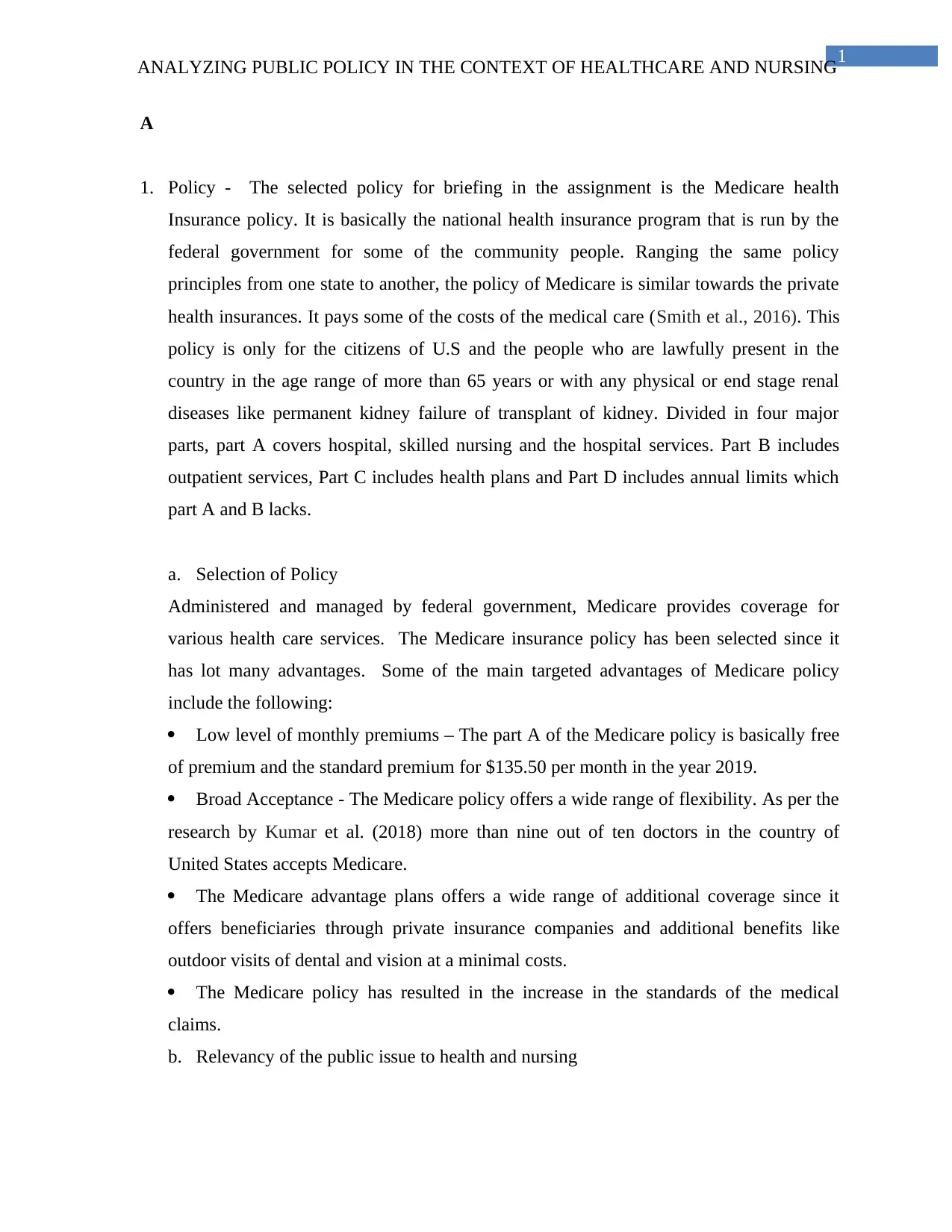
1
ANALYZING PUBLIC POLICY IN THE CONTEXT OF HEALTHCARE AND NURSING
A
1. Policy - The selected policy for briefing in the assignment is the Medicare health
Insurance policy. It is basically the national health insurance program that is run by the
federal government for some of the community people. Ranging the same policy
principles from one state to another, the policy of Medicare is similar towards the private
health insurances. It pays some of the costs of the medical care (Smith et al., 2016). This
policy is only for the citizens of U.S and the people who are lawfully present in the
country in the age range of more than 65 years or with any physical or end stage renal
diseases like permanent kidney failure of transplant of kidney. Divided in four major
parts, part A covers hospital, skilled nursing and the hospital services. Part B includes
outpatient services, Part C includes health plans and Part D includes annual limits which
part A and B lacks.
a. Selection of Policy
Administered and managed by federal government, Medicare provides coverage for
various health care services. The Medicare insurance policy has been selected since it
has lot many advantages. Some of the main targeted advantages of Medicare policy
include the following:
Low level of monthly premiums – The part A of the Medicare policy is basically free
of premium and the standard premium for $135.50 per month in the year 2019.
Broad Acceptance - The Medicare policy offers a wide range of flexibility. As per the
research by Kumar et al. (2018) more than nine out of ten doctors in the country of
United States accepts Medicare.
The Medicare advantage plans offers a wide range of additional coverage since it
offers beneficiaries through private insurance companies and additional benefits like
outdoor visits of dental and vision at a minimal costs.
The Medicare policy has resulted in the increase in the standards of the medical
claims.
b. Relevancy of the public issue to health and nursing
ANALYZING PUBLIC POLICY IN THE CONTEXT OF HEALTHCARE AND NURSING
A
1. Policy - The selected policy for briefing in the assignment is the Medicare health
Insurance policy. It is basically the national health insurance program that is run by the
federal government for some of the community people. Ranging the same policy
principles from one state to another, the policy of Medicare is similar towards the private
health insurances. It pays some of the costs of the medical care (Smith et al., 2016). This
policy is only for the citizens of U.S and the people who are lawfully present in the
country in the age range of more than 65 years or with any physical or end stage renal
diseases like permanent kidney failure of transplant of kidney. Divided in four major
parts, part A covers hospital, skilled nursing and the hospital services. Part B includes
outpatient services, Part C includes health plans and Part D includes annual limits which
part A and B lacks.
a. Selection of Policy
Administered and managed by federal government, Medicare provides coverage for
various health care services. The Medicare insurance policy has been selected since it
has lot many advantages. Some of the main targeted advantages of Medicare policy
include the following:
Low level of monthly premiums – The part A of the Medicare policy is basically free
of premium and the standard premium for $135.50 per month in the year 2019.
Broad Acceptance - The Medicare policy offers a wide range of flexibility. As per the
research by Kumar et al. (2018) more than nine out of ten doctors in the country of
United States accepts Medicare.
The Medicare advantage plans offers a wide range of additional coverage since it
offers beneficiaries through private insurance companies and additional benefits like
outdoor visits of dental and vision at a minimal costs.
The Medicare policy has resulted in the increase in the standards of the medical
claims.
b. Relevancy of the public issue to health and nursing
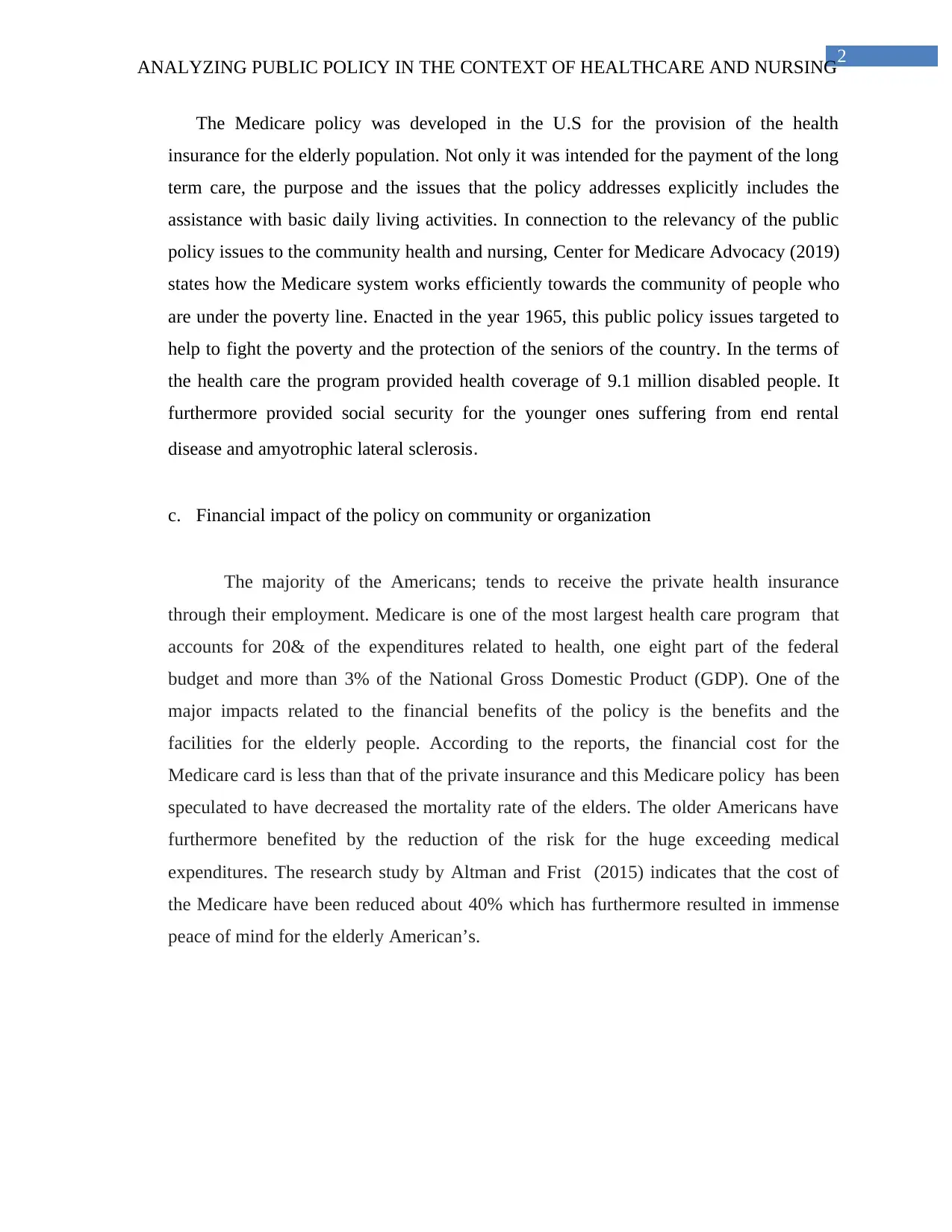
2
ANALYZING PUBLIC POLICY IN THE CONTEXT OF HEALTHCARE AND NURSING
The Medicare policy was developed in the U.S for the provision of the health
insurance for the elderly population. Not only it was intended for the payment of the long
term care, the purpose and the issues that the policy addresses explicitly includes the
assistance with basic daily living activities. In connection to the relevancy of the public
policy issues to the community health and nursing, Center for Medicare Advocacy (2019)
states how the Medicare system works efficiently towards the community of people who
are under the poverty line. Enacted in the year 1965, this public policy issues targeted to
help to fight the poverty and the protection of the seniors of the country. In the terms of
the health care the program provided health coverage of 9.1 million disabled people. It
furthermore provided social security for the younger ones suffering from end rental
disease and amyotrophic lateral sclerosis.
c. Financial impact of the policy on community or organization
The majority of the Americans; tends to receive the private health insurance
through their employment. Medicare is one of the most largest health care program that
accounts for 20& of the expenditures related to health, one eight part of the federal
budget and more than 3% of the National Gross Domestic Product (GDP). One of the
major impacts related to the financial benefits of the policy is the benefits and the
facilities for the elderly people. According to the reports, the financial cost for the
Medicare card is less than that of the private insurance and this Medicare policy has been
speculated to have decreased the mortality rate of the elders. The older Americans have
furthermore benefited by the reduction of the risk for the huge exceeding medical
expenditures. The research study by Altman and Frist (2015) indicates that the cost of
the Medicare have been reduced about 40% which has furthermore resulted in immense
peace of mind for the elderly American’s.
ANALYZING PUBLIC POLICY IN THE CONTEXT OF HEALTHCARE AND NURSING
The Medicare policy was developed in the U.S for the provision of the health
insurance for the elderly population. Not only it was intended for the payment of the long
term care, the purpose and the issues that the policy addresses explicitly includes the
assistance with basic daily living activities. In connection to the relevancy of the public
policy issues to the community health and nursing, Center for Medicare Advocacy (2019)
states how the Medicare system works efficiently towards the community of people who
are under the poverty line. Enacted in the year 1965, this public policy issues targeted to
help to fight the poverty and the protection of the seniors of the country. In the terms of
the health care the program provided health coverage of 9.1 million disabled people. It
furthermore provided social security for the younger ones suffering from end rental
disease and amyotrophic lateral sclerosis.
c. Financial impact of the policy on community or organization
The majority of the Americans; tends to receive the private health insurance
through their employment. Medicare is one of the most largest health care program that
accounts for 20& of the expenditures related to health, one eight part of the federal
budget and more than 3% of the National Gross Domestic Product (GDP). One of the
major impacts related to the financial benefits of the policy is the benefits and the
facilities for the elderly people. According to the reports, the financial cost for the
Medicare card is less than that of the private insurance and this Medicare policy has been
speculated to have decreased the mortality rate of the elders. The older Americans have
furthermore benefited by the reduction of the risk for the huge exceeding medical
expenditures. The research study by Altman and Frist (2015) indicates that the cost of
the Medicare have been reduced about 40% which has furthermore resulted in immense
peace of mind for the elderly American’s.
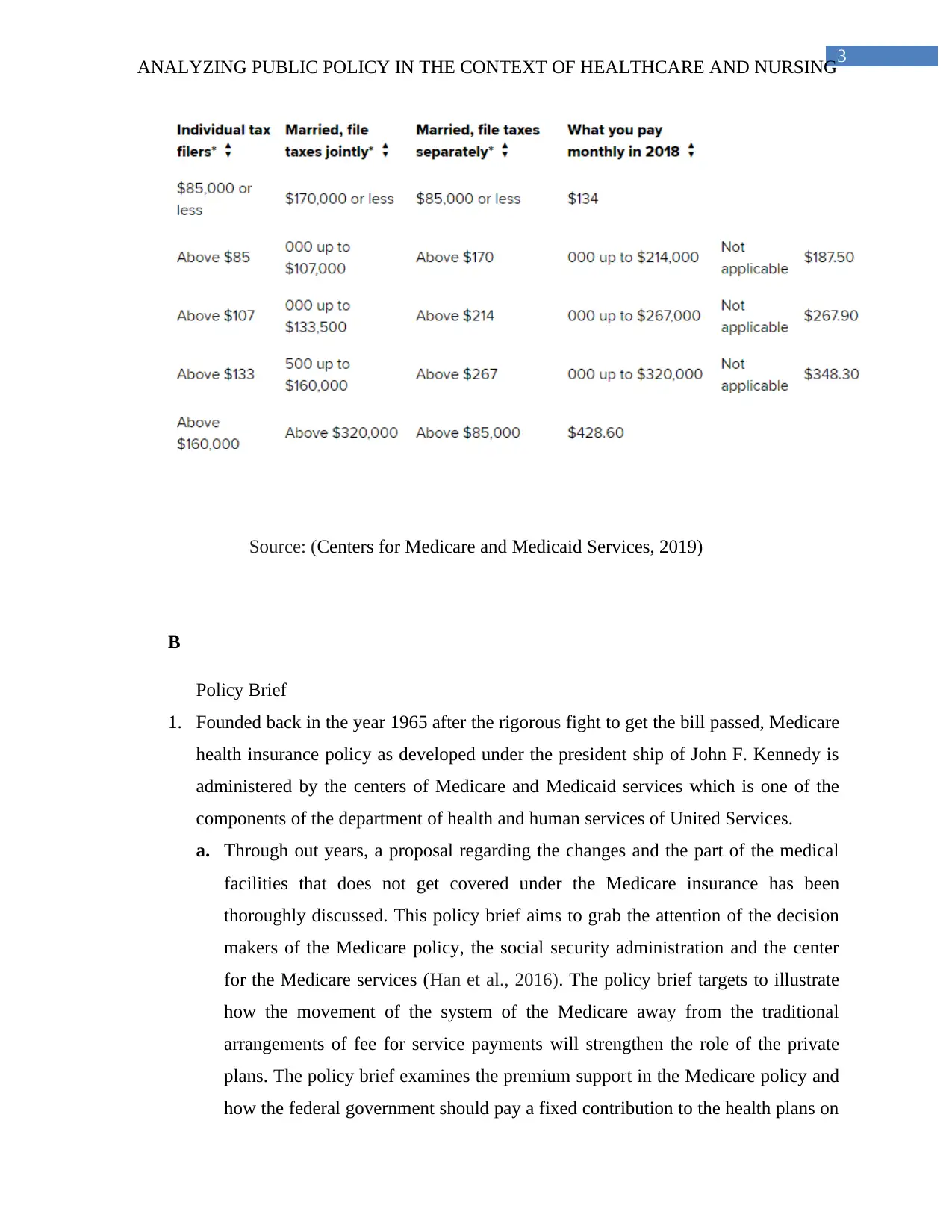
3
ANALYZING PUBLIC POLICY IN THE CONTEXT OF HEALTHCARE AND NURSING
Source: (Centers for Medicare and Medicaid Services, 2019)
B
Policy Brief
1. Founded back in the year 1965 after the rigorous fight to get the bill passed, Medicare
health insurance policy as developed under the president ship of John F. Kennedy is
administered by the centers of Medicare and Medicaid services which is one of the
components of the department of health and human services of United Services.
a. Through out years, a proposal regarding the changes and the part of the medical
facilities that does not get covered under the Medicare insurance has been
thoroughly discussed. This policy brief aims to grab the attention of the decision
makers of the Medicare policy, the social security administration and the center
for the Medicare services (Han et al., 2016). The policy brief targets to illustrate
how the movement of the system of the Medicare away from the traditional
arrangements of fee for service payments will strengthen the role of the private
plans. The policy brief examines the premium support in the Medicare policy and
how the federal government should pay a fixed contribution to the health plans on
ANALYZING PUBLIC POLICY IN THE CONTEXT OF HEALTHCARE AND NURSING
Source: (Centers for Medicare and Medicaid Services, 2019)
B
Policy Brief
1. Founded back in the year 1965 after the rigorous fight to get the bill passed, Medicare
health insurance policy as developed under the president ship of John F. Kennedy is
administered by the centers of Medicare and Medicaid services which is one of the
components of the department of health and human services of United Services.
a. Through out years, a proposal regarding the changes and the part of the medical
facilities that does not get covered under the Medicare insurance has been
thoroughly discussed. This policy brief aims to grab the attention of the decision
makers of the Medicare policy, the social security administration and the center
for the Medicare services (Han et al., 2016). The policy brief targets to illustrate
how the movement of the system of the Medicare away from the traditional
arrangements of fee for service payments will strengthen the role of the private
plans. The policy brief examines the premium support in the Medicare policy and
how the federal government should pay a fixed contribution to the health plans on
Secure Best Marks with AI Grader
Need help grading? Try our AI Grader for instant feedback on your assignments.
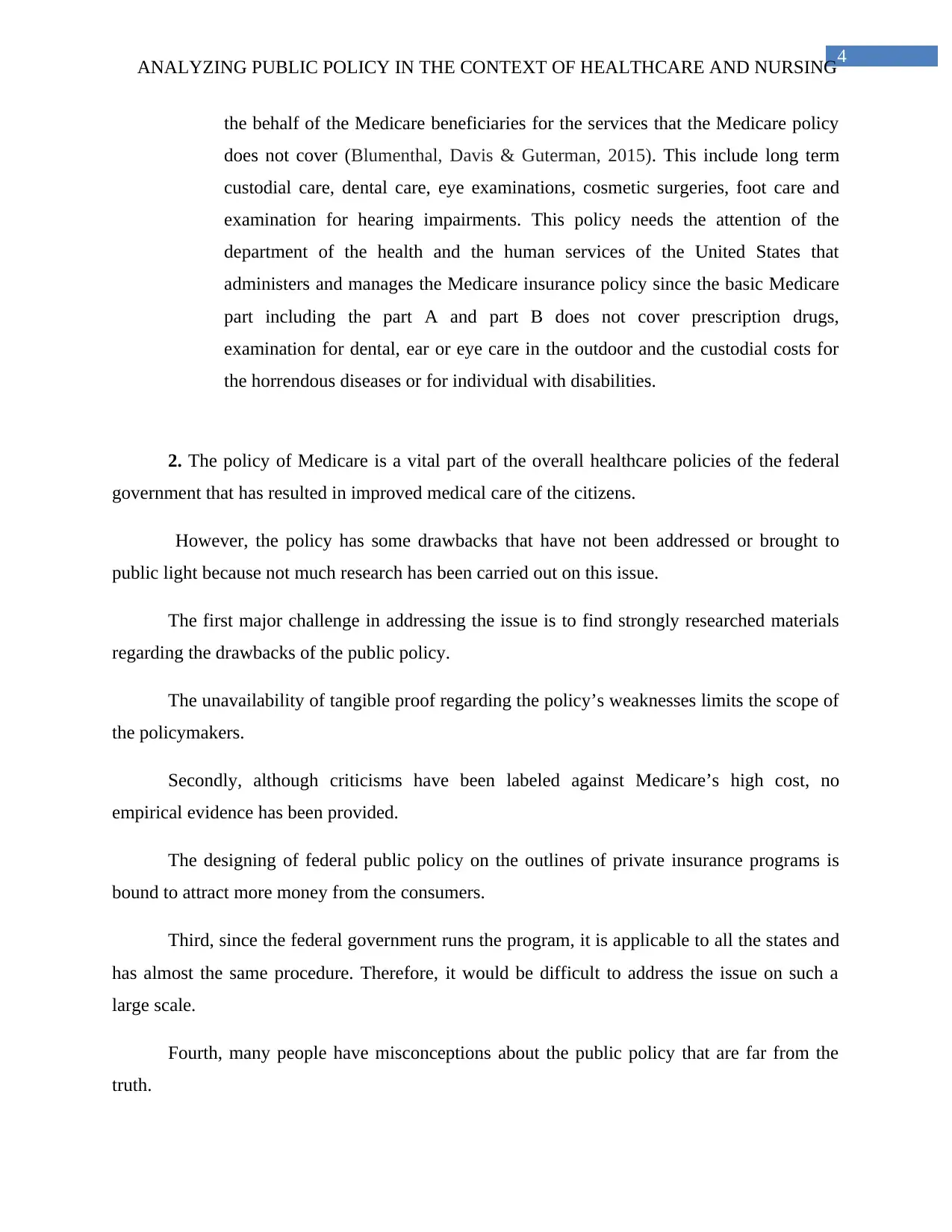
4
ANALYZING PUBLIC POLICY IN THE CONTEXT OF HEALTHCARE AND NURSING
the behalf of the Medicare beneficiaries for the services that the Medicare policy
does not cover (Blumenthal, Davis & Guterman, 2015). This include long term
custodial care, dental care, eye examinations, cosmetic surgeries, foot care and
examination for hearing impairments. This policy needs the attention of the
department of the health and the human services of the United States that
administers and manages the Medicare insurance policy since the basic Medicare
part including the part A and part B does not cover prescription drugs,
examination for dental, ear or eye care in the outdoor and the custodial costs for
the horrendous diseases or for individual with disabilities.
2. The policy of Medicare is a vital part of the overall healthcare policies of the federal
government that has resulted in improved medical care of the citizens.
However, the policy has some drawbacks that have not been addressed or brought to
public light because not much research has been carried out on this issue.
The first major challenge in addressing the issue is to find strongly researched materials
regarding the drawbacks of the public policy.
The unavailability of tangible proof regarding the policy’s weaknesses limits the scope of
the policymakers.
Secondly, although criticisms have been labeled against Medicare’s high cost, no
empirical evidence has been provided.
The designing of federal public policy on the outlines of private insurance programs is
bound to attract more money from the consumers.
Third, since the federal government runs the program, it is applicable to all the states and
has almost the same procedure. Therefore, it would be difficult to address the issue on such a
large scale.
Fourth, many people have misconceptions about the public policy that are far from the
truth.
ANALYZING PUBLIC POLICY IN THE CONTEXT OF HEALTHCARE AND NURSING
the behalf of the Medicare beneficiaries for the services that the Medicare policy
does not cover (Blumenthal, Davis & Guterman, 2015). This include long term
custodial care, dental care, eye examinations, cosmetic surgeries, foot care and
examination for hearing impairments. This policy needs the attention of the
department of the health and the human services of the United States that
administers and manages the Medicare insurance policy since the basic Medicare
part including the part A and part B does not cover prescription drugs,
examination for dental, ear or eye care in the outdoor and the custodial costs for
the horrendous diseases or for individual with disabilities.
2. The policy of Medicare is a vital part of the overall healthcare policies of the federal
government that has resulted in improved medical care of the citizens.
However, the policy has some drawbacks that have not been addressed or brought to
public light because not much research has been carried out on this issue.
The first major challenge in addressing the issue is to find strongly researched materials
regarding the drawbacks of the public policy.
The unavailability of tangible proof regarding the policy’s weaknesses limits the scope of
the policymakers.
Secondly, although criticisms have been labeled against Medicare’s high cost, no
empirical evidence has been provided.
The designing of federal public policy on the outlines of private insurance programs is
bound to attract more money from the consumers.
Third, since the federal government runs the program, it is applicable to all the states and
has almost the same procedure. Therefore, it would be difficult to address the issue on such a
large scale.
Fourth, many people have misconceptions about the public policy that are far from the
truth.

5
ANALYZING PUBLIC POLICY IN THE CONTEXT OF HEALTHCARE AND NURSING
Addressing this issue is challenging because the misconceptions and myths are deep
rooted and it would be difficult for the policy makers to remove the myths and misconceptions.
The fifth challenge derives from the fourth because along with the myths and
misconceptions, the policy has some drawbacks, which would be difficult for the policy change
advocates to sieve.
To filter the truth from the myth is very challenging because it has to be done with strong
evidence and research.
3. The Medicare facilities have been providing guaranteed health benefits to millions of
the adults and the people with disabilities. Some of the primary interventions for the decision
maker including the factor of the tangibility projects the importance and the essentiality of the
improvement of the health care policy systems. It is critically essential for the lawmakers and the
members of the health care community to advance the global changes for the modernizing of the
benefits in case of both Medicare and private Medicare health plans. Some of the tangible factors
include the importance for the policy makers of the Medicare policy to improve how the
beneficiaries navigate towards the day to day coverage (Flood, Marchildon & Paech, 2018).
Some of the primary options include addition of the dental benefits, making of the Medicare
system more affordable, covering the vision and hearing care, expansion of the coverage for the
long term services and the supports, addition of standard Medicare out of the pocket for the
maximum for the beneficiary of the sharing of the cost and the consolidation and the standardize
of the advantage of the Medicare and the Part D of the Medicare plans. Furthermore some of the
tangible factors in the intervention includes elimination of the test of the assessment for the low
income assistance of the Medicare program, improvement and the streamline of the application
of the procedure of the low income Medicare assistance programs.
4. The course of action to be proposed to the decision maker must be succinct and
effective.
ANALYZING PUBLIC POLICY IN THE CONTEXT OF HEALTHCARE AND NURSING
Addressing this issue is challenging because the misconceptions and myths are deep
rooted and it would be difficult for the policy makers to remove the myths and misconceptions.
The fifth challenge derives from the fourth because along with the myths and
misconceptions, the policy has some drawbacks, which would be difficult for the policy change
advocates to sieve.
To filter the truth from the myth is very challenging because it has to be done with strong
evidence and research.
3. The Medicare facilities have been providing guaranteed health benefits to millions of
the adults and the people with disabilities. Some of the primary interventions for the decision
maker including the factor of the tangibility projects the importance and the essentiality of the
improvement of the health care policy systems. It is critically essential for the lawmakers and the
members of the health care community to advance the global changes for the modernizing of the
benefits in case of both Medicare and private Medicare health plans. Some of the tangible factors
include the importance for the policy makers of the Medicare policy to improve how the
beneficiaries navigate towards the day to day coverage (Flood, Marchildon & Paech, 2018).
Some of the primary options include addition of the dental benefits, making of the Medicare
system more affordable, covering the vision and hearing care, expansion of the coverage for the
long term services and the supports, addition of standard Medicare out of the pocket for the
maximum for the beneficiary of the sharing of the cost and the consolidation and the standardize
of the advantage of the Medicare and the Part D of the Medicare plans. Furthermore some of the
tangible factors in the intervention includes elimination of the test of the assessment for the low
income assistance of the Medicare program, improvement and the streamline of the application
of the procedure of the low income Medicare assistance programs.
4. The course of action to be proposed to the decision maker must be succinct and
effective.
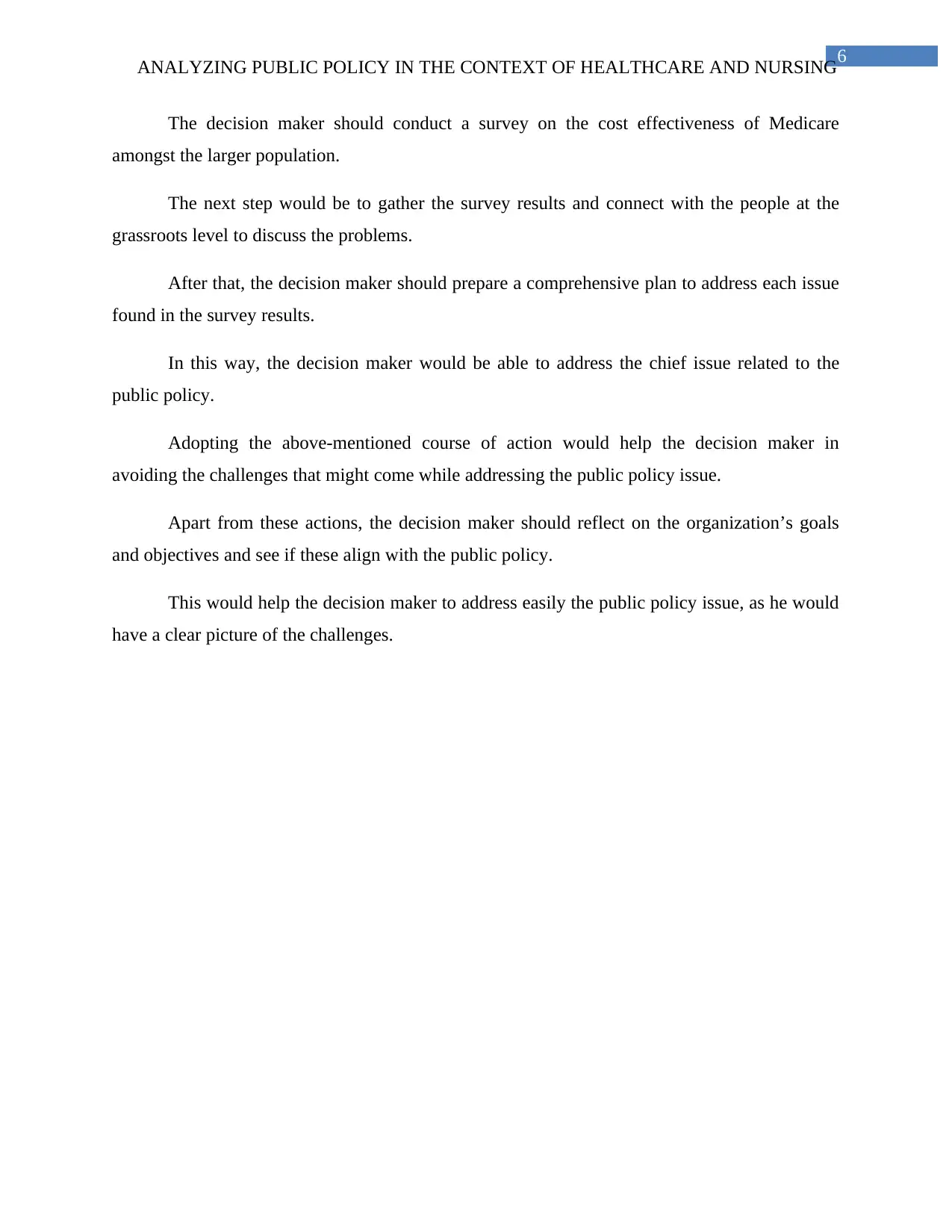
6
ANALYZING PUBLIC POLICY IN THE CONTEXT OF HEALTHCARE AND NURSING
The decision maker should conduct a survey on the cost effectiveness of Medicare
amongst the larger population.
The next step would be to gather the survey results and connect with the people at the
grassroots level to discuss the problems.
After that, the decision maker should prepare a comprehensive plan to address each issue
found in the survey results.
In this way, the decision maker would be able to address the chief issue related to the
public policy.
Adopting the above-mentioned course of action would help the decision maker in
avoiding the challenges that might come while addressing the public policy issue.
Apart from these actions, the decision maker should reflect on the organization’s goals
and objectives and see if these align with the public policy.
This would help the decision maker to address easily the public policy issue, as he would
have a clear picture of the challenges.
ANALYZING PUBLIC POLICY IN THE CONTEXT OF HEALTHCARE AND NURSING
The decision maker should conduct a survey on the cost effectiveness of Medicare
amongst the larger population.
The next step would be to gather the survey results and connect with the people at the
grassroots level to discuss the problems.
After that, the decision maker should prepare a comprehensive plan to address each issue
found in the survey results.
In this way, the decision maker would be able to address the chief issue related to the
public policy.
Adopting the above-mentioned course of action would help the decision maker in
avoiding the challenges that might come while addressing the public policy issue.
Apart from these actions, the decision maker should reflect on the organization’s goals
and objectives and see if these align with the public policy.
This would help the decision maker to address easily the public policy issue, as he would
have a clear picture of the challenges.
Paraphrase This Document
Need a fresh take? Get an instant paraphrase of this document with our AI Paraphraser
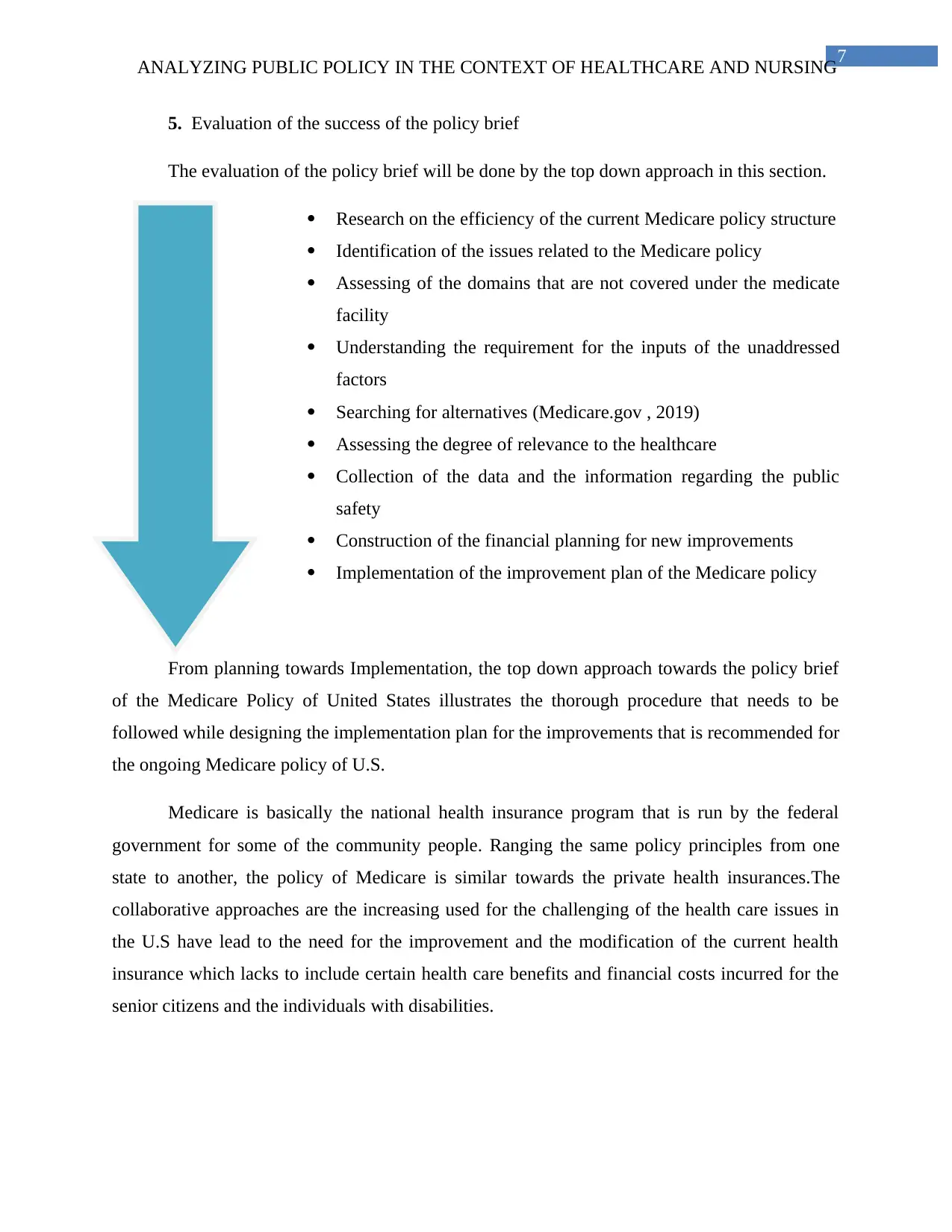
7
ANALYZING PUBLIC POLICY IN THE CONTEXT OF HEALTHCARE AND NURSING
5. Evaluation of the success of the policy brief
The evaluation of the policy brief will be done by the top down approach in this section.
Research on the efficiency of the current Medicare policy structure
Identification of the issues related to the Medicare policy
Assessing of the domains that are not covered under the medicate
facility
Understanding the requirement for the inputs of the unaddressed
factors
Searching for alternatives (Medicare.gov , 2019)
Assessing the degree of relevance to the healthcare
Collection of the data and the information regarding the public
safety
Construction of the financial planning for new improvements
Implementation of the improvement plan of the Medicare policy
From planning towards Implementation, the top down approach towards the policy brief
of the Medicare Policy of United States illustrates the thorough procedure that needs to be
followed while designing the implementation plan for the improvements that is recommended for
the ongoing Medicare policy of U.S.
Medicare is basically the national health insurance program that is run by the federal
government for some of the community people. Ranging the same policy principles from one
state to another, the policy of Medicare is similar towards the private health insurances.The
collaborative approaches are the increasing used for the challenging of the health care issues in
the U.S have lead to the need for the improvement and the modification of the current health
insurance which lacks to include certain health care benefits and financial costs incurred for the
senior citizens and the individuals with disabilities.
ANALYZING PUBLIC POLICY IN THE CONTEXT OF HEALTHCARE AND NURSING
5. Evaluation of the success of the policy brief
The evaluation of the policy brief will be done by the top down approach in this section.
Research on the efficiency of the current Medicare policy structure
Identification of the issues related to the Medicare policy
Assessing of the domains that are not covered under the medicate
facility
Understanding the requirement for the inputs of the unaddressed
factors
Searching for alternatives (Medicare.gov , 2019)
Assessing the degree of relevance to the healthcare
Collection of the data and the information regarding the public
safety
Construction of the financial planning for new improvements
Implementation of the improvement plan of the Medicare policy
From planning towards Implementation, the top down approach towards the policy brief
of the Medicare Policy of United States illustrates the thorough procedure that needs to be
followed while designing the implementation plan for the improvements that is recommended for
the ongoing Medicare policy of U.S.
Medicare is basically the national health insurance program that is run by the federal
government for some of the community people. Ranging the same policy principles from one
state to another, the policy of Medicare is similar towards the private health insurances.The
collaborative approaches are the increasing used for the challenging of the health care issues in
the U.S have lead to the need for the improvement and the modification of the current health
insurance which lacks to include certain health care benefits and financial costs incurred for the
senior citizens and the individuals with disabilities.
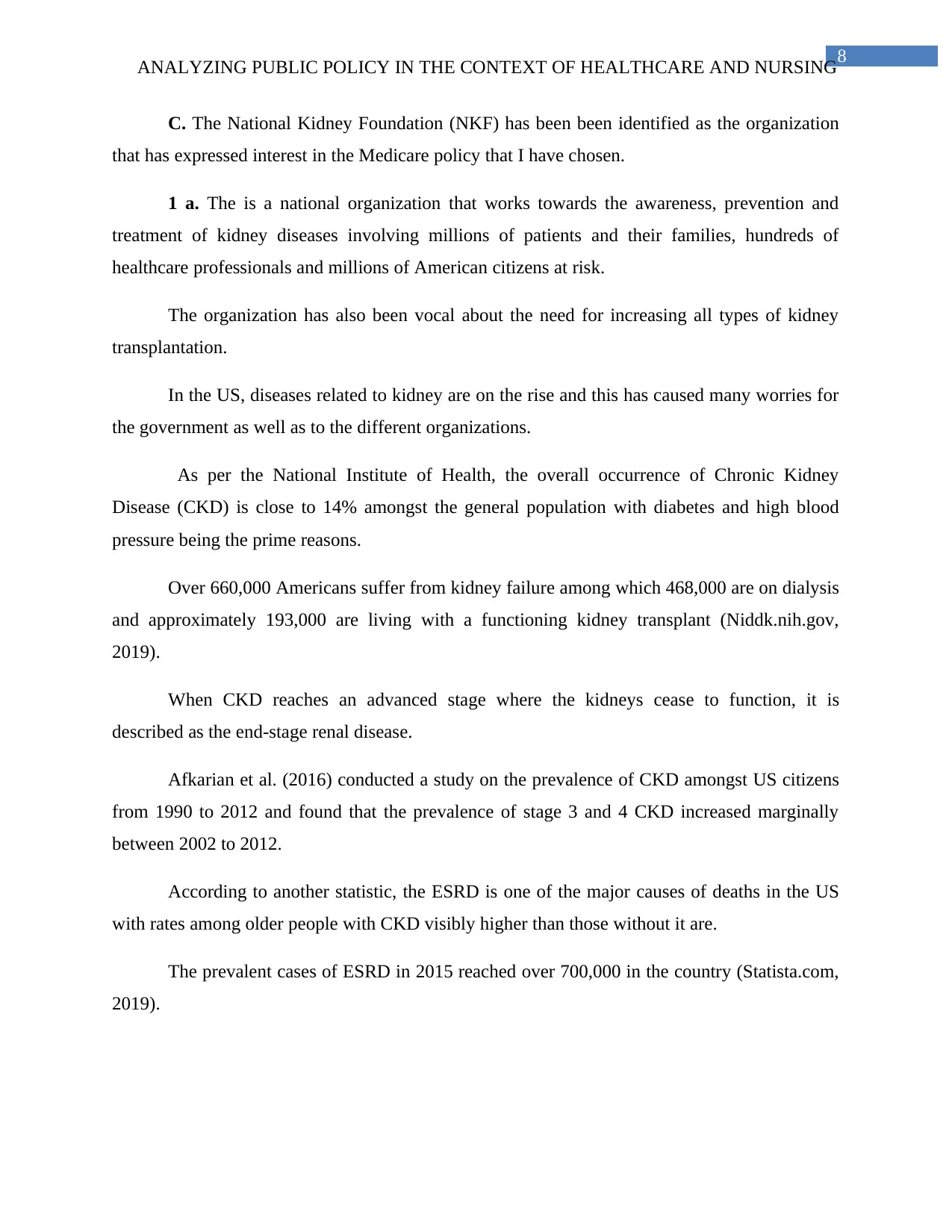
8
ANALYZING PUBLIC POLICY IN THE CONTEXT OF HEALTHCARE AND NURSING
C. The National Kidney Foundation (NKF) has been been identified as the organization
that has expressed interest in the Medicare policy that I have chosen.
1 a. The is a national organization that works towards the awareness, prevention and
treatment of kidney diseases involving millions of patients and their families, hundreds of
healthcare professionals and millions of American citizens at risk.
The organization has also been vocal about the need for increasing all types of kidney
transplantation.
In the US, diseases related to kidney are on the rise and this has caused many worries for
the government as well as to the different organizations.
As per the National Institute of Health, the overall occurrence of Chronic Kidney
Disease (CKD) is close to 14% amongst the general population with diabetes and high blood
pressure being the prime reasons.
Over 660,000 Americans suffer from kidney failure among which 468,000 are on dialysis
and approximately 193,000 are living with a functioning kidney transplant (Niddk.nih.gov,
2019).
When CKD reaches an advanced stage where the kidneys cease to function, it is
described as the end-stage renal disease.
Afkarian et al. (2016) conducted a study on the prevalence of CKD amongst US citizens
from 1990 to 2012 and found that the prevalence of stage 3 and 4 CKD increased marginally
between 2002 to 2012.
According to another statistic, the ESRD is one of the major causes of deaths in the US
with rates among older people with CKD visibly higher than those without it are.
The prevalent cases of ESRD in 2015 reached over 700,000 in the country (Statista.com,
2019).
ANALYZING PUBLIC POLICY IN THE CONTEXT OF HEALTHCARE AND NURSING
C. The National Kidney Foundation (NKF) has been been identified as the organization
that has expressed interest in the Medicare policy that I have chosen.
1 a. The is a national organization that works towards the awareness, prevention and
treatment of kidney diseases involving millions of patients and their families, hundreds of
healthcare professionals and millions of American citizens at risk.
The organization has also been vocal about the need for increasing all types of kidney
transplantation.
In the US, diseases related to kidney are on the rise and this has caused many worries for
the government as well as to the different organizations.
As per the National Institute of Health, the overall occurrence of Chronic Kidney
Disease (CKD) is close to 14% amongst the general population with diabetes and high blood
pressure being the prime reasons.
Over 660,000 Americans suffer from kidney failure among which 468,000 are on dialysis
and approximately 193,000 are living with a functioning kidney transplant (Niddk.nih.gov,
2019).
When CKD reaches an advanced stage where the kidneys cease to function, it is
described as the end-stage renal disease.
Afkarian et al. (2016) conducted a study on the prevalence of CKD amongst US citizens
from 1990 to 2012 and found that the prevalence of stage 3 and 4 CKD increased marginally
between 2002 to 2012.
According to another statistic, the ESRD is one of the major causes of deaths in the US
with rates among older people with CKD visibly higher than those without it are.
The prevalent cases of ESRD in 2015 reached over 700,000 in the country (Statista.com,
2019).
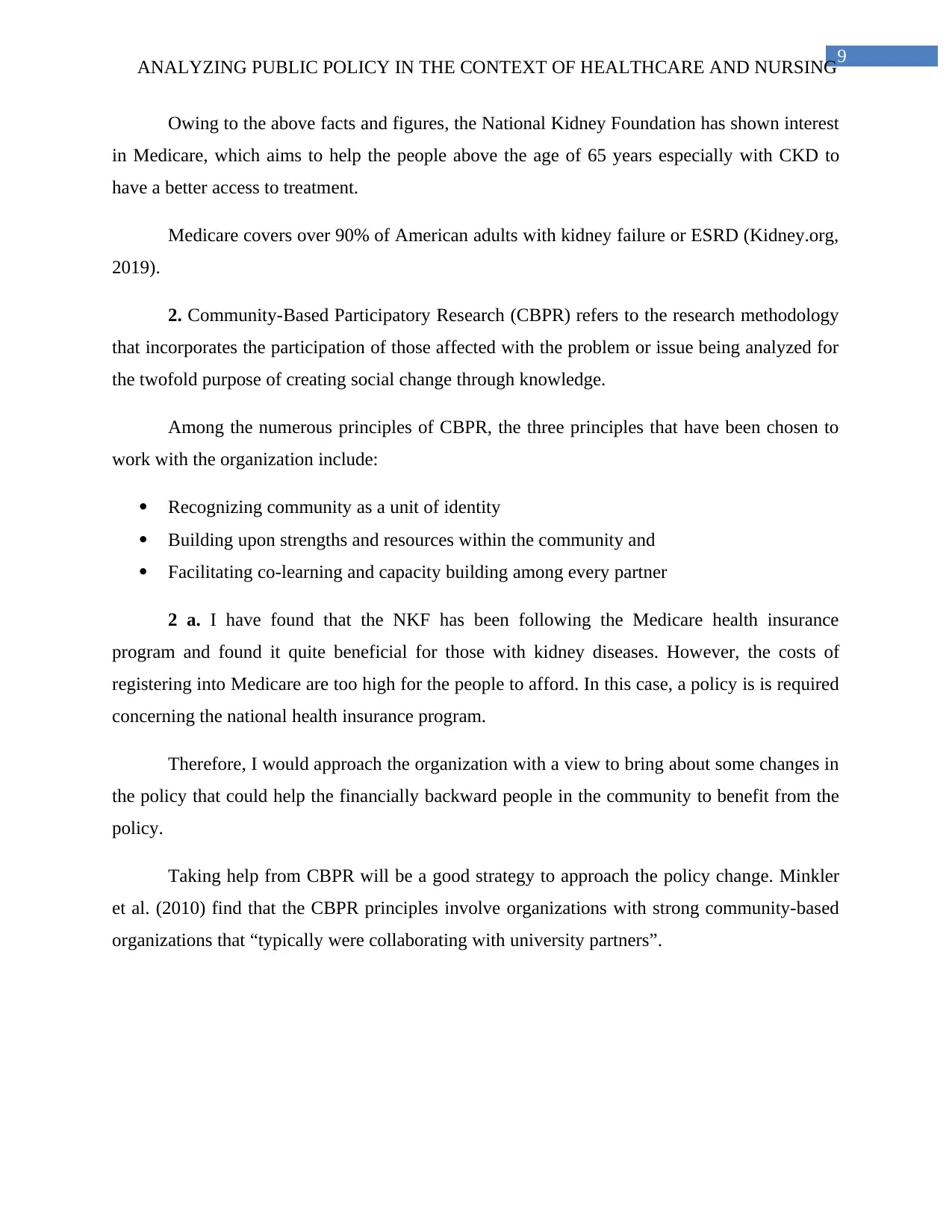
9
ANALYZING PUBLIC POLICY IN THE CONTEXT OF HEALTHCARE AND NURSING
Owing to the above facts and figures, the National Kidney Foundation has shown interest
in Medicare, which aims to help the people above the age of 65 years especially with CKD to
have a better access to treatment.
Medicare covers over 90% of American adults with kidney failure or ESRD (Kidney.org,
2019).
2. Community-Based Participatory Research (CBPR) refers to the research methodology
that incorporates the participation of those affected with the problem or issue being analyzed for
the twofold purpose of creating social change through knowledge.
Among the numerous principles of CBPR, the three principles that have been chosen to
work with the organization include:
Recognizing community as a unit of identity
Building upon strengths and resources within the community and
Facilitating co-learning and capacity building among every partner
2 a. I have found that the NKF has been following the Medicare health insurance
program and found it quite beneficial for those with kidney diseases. However, the costs of
registering into Medicare are too high for the people to afford. In this case, a policy is is required
concerning the national health insurance program.
Therefore, I would approach the organization with a view to bring about some changes in
the policy that could help the financially backward people in the community to benefit from the
policy.
Taking help from CBPR will be a good strategy to approach the policy change. Minkler
et al. (2010) find that the CBPR principles involve organizations with strong community-based
organizations that “typically were collaborating with university partners”.
ANALYZING PUBLIC POLICY IN THE CONTEXT OF HEALTHCARE AND NURSING
Owing to the above facts and figures, the National Kidney Foundation has shown interest
in Medicare, which aims to help the people above the age of 65 years especially with CKD to
have a better access to treatment.
Medicare covers over 90% of American adults with kidney failure or ESRD (Kidney.org,
2019).
2. Community-Based Participatory Research (CBPR) refers to the research methodology
that incorporates the participation of those affected with the problem or issue being analyzed for
the twofold purpose of creating social change through knowledge.
Among the numerous principles of CBPR, the three principles that have been chosen to
work with the organization include:
Recognizing community as a unit of identity
Building upon strengths and resources within the community and
Facilitating co-learning and capacity building among every partner
2 a. I have found that the NKF has been following the Medicare health insurance
program and found it quite beneficial for those with kidney diseases. However, the costs of
registering into Medicare are too high for the people to afford. In this case, a policy is is required
concerning the national health insurance program.
Therefore, I would approach the organization with a view to bring about some changes in
the policy that could help the financially backward people in the community to benefit from the
policy.
Taking help from CBPR will be a good strategy to approach the policy change. Minkler
et al. (2010) find that the CBPR principles involve organizations with strong community-based
organizations that “typically were collaborating with university partners”.
Secure Best Marks with AI Grader
Need help grading? Try our AI Grader for instant feedback on your assignments.
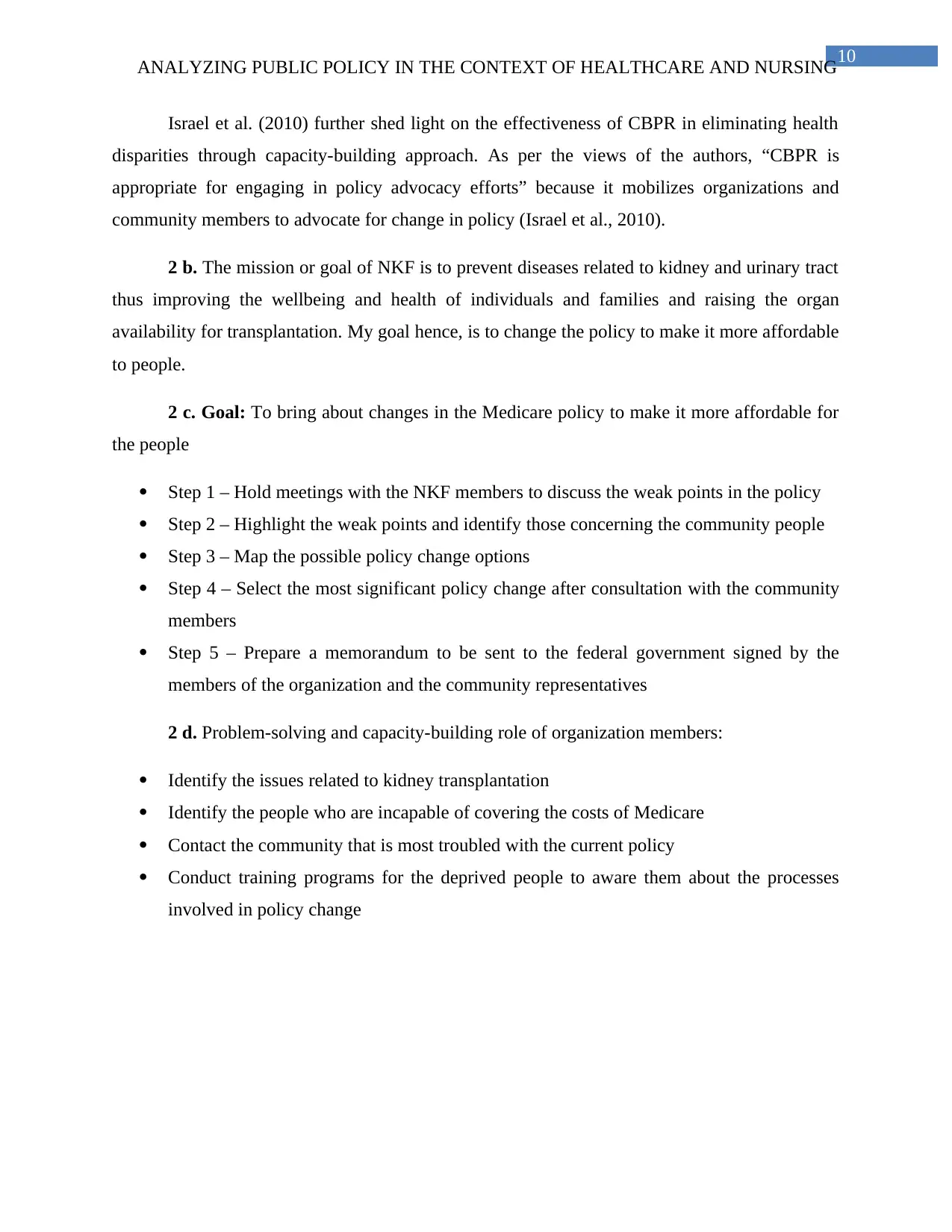
10
ANALYZING PUBLIC POLICY IN THE CONTEXT OF HEALTHCARE AND NURSING
Israel et al. (2010) further shed light on the effectiveness of CBPR in eliminating health
disparities through capacity-building approach. As per the views of the authors, “CBPR is
appropriate for engaging in policy advocacy efforts” because it mobilizes organizations and
community members to advocate for change in policy (Israel et al., 2010).
2 b. The mission or goal of NKF is to prevent diseases related to kidney and urinary tract
thus improving the wellbeing and health of individuals and families and raising the organ
availability for transplantation. My goal hence, is to change the policy to make it more affordable
to people.
2 c. Goal: To bring about changes in the Medicare policy to make it more affordable for
the people
Step 1 – Hold meetings with the NKF members to discuss the weak points in the policy
Step 2 – Highlight the weak points and identify those concerning the community people
Step 3 – Map the possible policy change options
Step 4 – Select the most significant policy change after consultation with the community
members
Step 5 – Prepare a memorandum to be sent to the federal government signed by the
members of the organization and the community representatives
2 d. Problem-solving and capacity-building role of organization members:
Identify the issues related to kidney transplantation
Identify the people who are incapable of covering the costs of Medicare
Contact the community that is most troubled with the current policy
Conduct training programs for the deprived people to aware them about the processes
involved in policy change
ANALYZING PUBLIC POLICY IN THE CONTEXT OF HEALTHCARE AND NURSING
Israel et al. (2010) further shed light on the effectiveness of CBPR in eliminating health
disparities through capacity-building approach. As per the views of the authors, “CBPR is
appropriate for engaging in policy advocacy efforts” because it mobilizes organizations and
community members to advocate for change in policy (Israel et al., 2010).
2 b. The mission or goal of NKF is to prevent diseases related to kidney and urinary tract
thus improving the wellbeing and health of individuals and families and raising the organ
availability for transplantation. My goal hence, is to change the policy to make it more affordable
to people.
2 c. Goal: To bring about changes in the Medicare policy to make it more affordable for
the people
Step 1 – Hold meetings with the NKF members to discuss the weak points in the policy
Step 2 – Highlight the weak points and identify those concerning the community people
Step 3 – Map the possible policy change options
Step 4 – Select the most significant policy change after consultation with the community
members
Step 5 – Prepare a memorandum to be sent to the federal government signed by the
members of the organization and the community representatives
2 d. Problem-solving and capacity-building role of organization members:
Identify the issues related to kidney transplantation
Identify the people who are incapable of covering the costs of Medicare
Contact the community that is most troubled with the current policy
Conduct training programs for the deprived people to aware them about the processes
involved in policy change

11
ANALYZING PUBLIC POLICY IN THE CONTEXT OF HEALTHCARE AND NURSING
2 e. After setting the objectives to meet the goal and deciding on the roles and
responsibilities of the organization members, it is important that we discuss the main aspects of
developing an evaluation plan.
The evaluation plan should be collaborative, that is, it should include both members of
the organization and members of the community.
The organization members must involve the community members taking them as one
identity even if there is presence of different race or ethnicity.
Further, the evaluation plan should be prepared with ideas and thoughts from the
community members thus acknowledging their skills and assets.
In addition, the evaluation plan should be made collaborative by including the rich
knowledge of the community members about the history, culture and social context that could
help evaluate any policy with a better understanding.
2 f. I will evaluate the organization’s plan and its success using the bottom-up approach.
First, I will analyze whether the small objectives have been met or not.
Then, I will evaluate whether the organization has utilized the skills and ideas of the
community members and included those within the policy change plan.
Lastly, I will evaluate whether the primary goal of changing the Medicare policy to make
it affordable to the entire population has been fulfilled or not.
ANALYZING PUBLIC POLICY IN THE CONTEXT OF HEALTHCARE AND NURSING
2 e. After setting the objectives to meet the goal and deciding on the roles and
responsibilities of the organization members, it is important that we discuss the main aspects of
developing an evaluation plan.
The evaluation plan should be collaborative, that is, it should include both members of
the organization and members of the community.
The organization members must involve the community members taking them as one
identity even if there is presence of different race or ethnicity.
Further, the evaluation plan should be prepared with ideas and thoughts from the
community members thus acknowledging their skills and assets.
In addition, the evaluation plan should be made collaborative by including the rich
knowledge of the community members about the history, culture and social context that could
help evaluate any policy with a better understanding.
2 f. I will evaluate the organization’s plan and its success using the bottom-up approach.
First, I will analyze whether the small objectives have been met or not.
Then, I will evaluate whether the organization has utilized the skills and ideas of the
community members and included those within the policy change plan.
Lastly, I will evaluate whether the primary goal of changing the Medicare policy to make
it affordable to the entire population has been fulfilled or not.

12
ANALYZING PUBLIC POLICY IN THE CONTEXT OF HEALTHCARE AND NURSING
D 1. Strengths of top-down approach and bottom-up approach:
In top-down approach, decisions are made and implemented in a short time. Further, the
approach helps align the objectives with the goals of the organization.
In bottom-up approach, the members who are actively participating in the policy change
project have the freedom to express their opinions and collaborative decisions are made.
The bottom-up approach further has the strength to empower members of the team by
motivating them to give their best. This happens when every member is equally valued
and appreciated.
D 2. Challenges of top-down and bottom-up approach:
The most glaring challenge of top-down approach is that it does not involve the team,
which results in a hollow plan.
Further, the top-down approach only includes clear communication as the specific
requirement and unspecific requirements lead to misunderstandings thus causing the
project to fail.
The bottom-up approach is time-consuming and takes too much effort, as it is a much-
detailed plan.
The bottom-up approach also needs a clearly explained scope and control or else, it has
the risk of being out of control.
D 3. I would recommend the bottom-up approach as the most efficient approaches to
address the issues with Medicare. The reason is that this approach involves teamwork and team
appreciation.
Advocating for and demanding a policy change requires all the members of the
organization to work together with the people at the ground level. With the bottom-up approach,
people from the grassroots will be able to express their grievances regarding the high price of the
Medicare insurance.
ANALYZING PUBLIC POLICY IN THE CONTEXT OF HEALTHCARE AND NURSING
D 1. Strengths of top-down approach and bottom-up approach:
In top-down approach, decisions are made and implemented in a short time. Further, the
approach helps align the objectives with the goals of the organization.
In bottom-up approach, the members who are actively participating in the policy change
project have the freedom to express their opinions and collaborative decisions are made.
The bottom-up approach further has the strength to empower members of the team by
motivating them to give their best. This happens when every member is equally valued
and appreciated.
D 2. Challenges of top-down and bottom-up approach:
The most glaring challenge of top-down approach is that it does not involve the team,
which results in a hollow plan.
Further, the top-down approach only includes clear communication as the specific
requirement and unspecific requirements lead to misunderstandings thus causing the
project to fail.
The bottom-up approach is time-consuming and takes too much effort, as it is a much-
detailed plan.
The bottom-up approach also needs a clearly explained scope and control or else, it has
the risk of being out of control.
D 3. I would recommend the bottom-up approach as the most efficient approaches to
address the issues with Medicare. The reason is that this approach involves teamwork and team
appreciation.
Advocating for and demanding a policy change requires all the members of the
organization to work together with the people at the ground level. With the bottom-up approach,
people from the grassroots will be able to express their grievances regarding the high price of the
Medicare insurance.
Paraphrase This Document
Need a fresh take? Get an instant paraphrase of this document with our AI Paraphraser
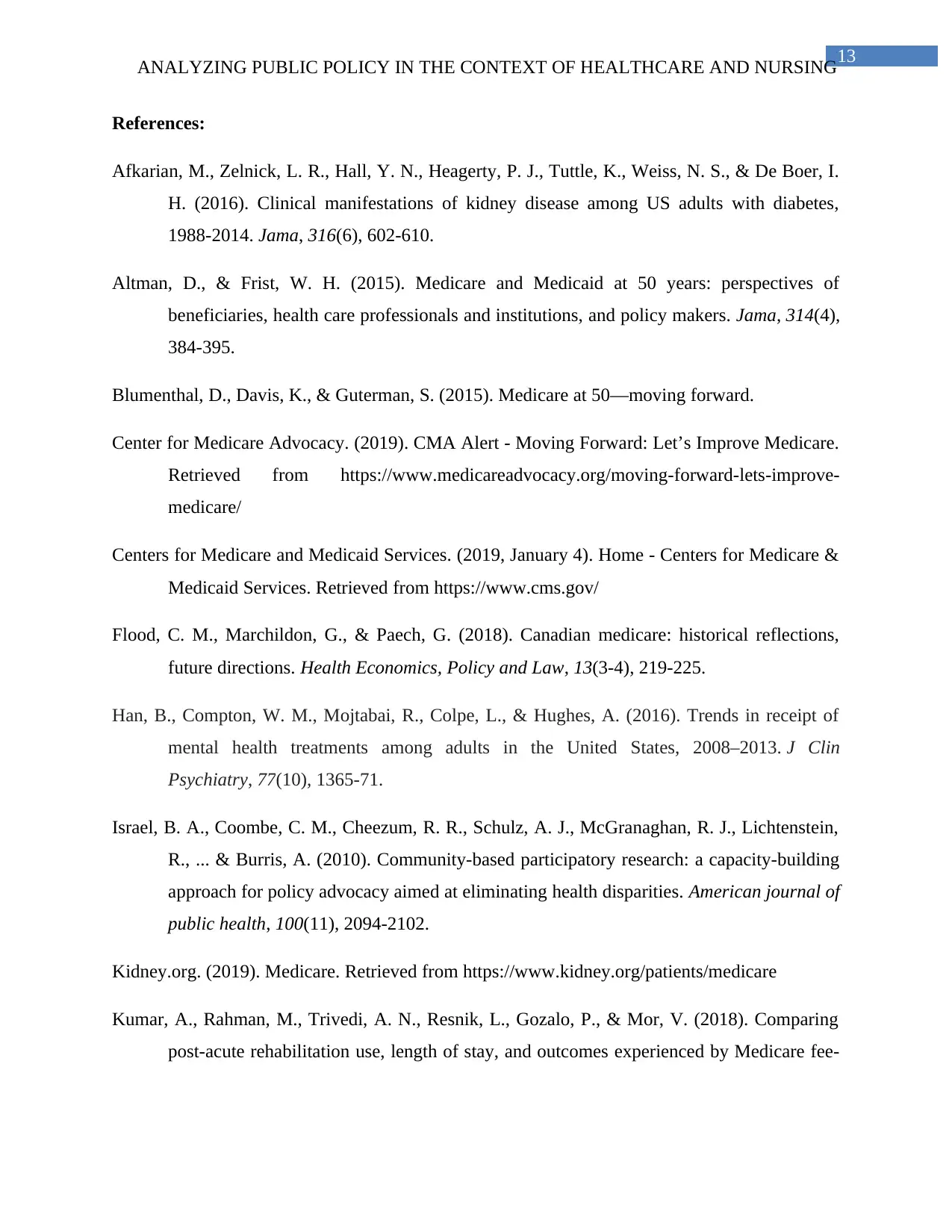
13
ANALYZING PUBLIC POLICY IN THE CONTEXT OF HEALTHCARE AND NURSING
References:
Afkarian, M., Zelnick, L. R., Hall, Y. N., Heagerty, P. J., Tuttle, K., Weiss, N. S., & De Boer, I.
H. (2016). Clinical manifestations of kidney disease among US adults with diabetes,
1988-2014. Jama, 316(6), 602-610.
Altman, D., & Frist, W. H. (2015). Medicare and Medicaid at 50 years: perspectives of
beneficiaries, health care professionals and institutions, and policy makers. Jama, 314(4),
384-395.
Blumenthal, D., Davis, K., & Guterman, S. (2015). Medicare at 50—moving forward.
Center for Medicare Advocacy. (2019). CMA Alert - Moving Forward: Let’s Improve Medicare.
Retrieved from https://www.medicareadvocacy.org/moving-forward-lets-improve-
medicare/
Centers for Medicare and Medicaid Services. (2019, January 4). Home - Centers for Medicare &
Medicaid Services. Retrieved from https://www.cms.gov/
Flood, C. M., Marchildon, G., & Paech, G. (2018). Canadian medicare: historical reflections,
future directions. Health Economics, Policy and Law, 13(3-4), 219-225.
Han, B., Compton, W. M., Mojtabai, R., Colpe, L., & Hughes, A. (2016). Trends in receipt of
mental health treatments among adults in the United States, 2008–2013. J Clin
Psychiatry, 77(10), 1365-71.
Israel, B. A., Coombe, C. M., Cheezum, R. R., Schulz, A. J., McGranaghan, R. J., Lichtenstein,
R., ... & Burris, A. (2010). Community-based participatory research: a capacity-building
approach for policy advocacy aimed at eliminating health disparities. American journal of
public health, 100(11), 2094-2102.
Kidney.org. (2019). Medicare. Retrieved from https://www.kidney.org/patients/medicare
Kumar, A., Rahman, M., Trivedi, A. N., Resnik, L., Gozalo, P., & Mor, V. (2018). Comparing
post-acute rehabilitation use, length of stay, and outcomes experienced by Medicare fee-
ANALYZING PUBLIC POLICY IN THE CONTEXT OF HEALTHCARE AND NURSING
References:
Afkarian, M., Zelnick, L. R., Hall, Y. N., Heagerty, P. J., Tuttle, K., Weiss, N. S., & De Boer, I.
H. (2016). Clinical manifestations of kidney disease among US adults with diabetes,
1988-2014. Jama, 316(6), 602-610.
Altman, D., & Frist, W. H. (2015). Medicare and Medicaid at 50 years: perspectives of
beneficiaries, health care professionals and institutions, and policy makers. Jama, 314(4),
384-395.
Blumenthal, D., Davis, K., & Guterman, S. (2015). Medicare at 50—moving forward.
Center for Medicare Advocacy. (2019). CMA Alert - Moving Forward: Let’s Improve Medicare.
Retrieved from https://www.medicareadvocacy.org/moving-forward-lets-improve-
medicare/
Centers for Medicare and Medicaid Services. (2019, January 4). Home - Centers for Medicare &
Medicaid Services. Retrieved from https://www.cms.gov/
Flood, C. M., Marchildon, G., & Paech, G. (2018). Canadian medicare: historical reflections,
future directions. Health Economics, Policy and Law, 13(3-4), 219-225.
Han, B., Compton, W. M., Mojtabai, R., Colpe, L., & Hughes, A. (2016). Trends in receipt of
mental health treatments among adults in the United States, 2008–2013. J Clin
Psychiatry, 77(10), 1365-71.
Israel, B. A., Coombe, C. M., Cheezum, R. R., Schulz, A. J., McGranaghan, R. J., Lichtenstein,
R., ... & Burris, A. (2010). Community-based participatory research: a capacity-building
approach for policy advocacy aimed at eliminating health disparities. American journal of
public health, 100(11), 2094-2102.
Kidney.org. (2019). Medicare. Retrieved from https://www.kidney.org/patients/medicare
Kumar, A., Rahman, M., Trivedi, A. N., Resnik, L., Gozalo, P., & Mor, V. (2018). Comparing
post-acute rehabilitation use, length of stay, and outcomes experienced by Medicare fee-

14
ANALYZING PUBLIC POLICY IN THE CONTEXT OF HEALTHCARE AND NURSING
for-service and Medicare Advantage beneficiaries with hip fracture in the United States:
A secondary analysis of administrative data. PLoS medicine, 15(6), e1002592.
Medicare.gov. (2019). Medicare.gov: the official U.S. government site for Medicare | Medicare.
Retrieved from https://www.medicare.gov/
Niddk.nih.gov. (2019). Kidney Disease Statistics for the United States | NIDDK. Retrieved from
https://www.niddk.nih.gov/health-information/health-statistics/kidney-disease
Policylink.org. (2019). Promoting Healthy Public Policy through Community-Based
Participatory Research: Ten Case Studies | PolicyLink. Retrieved from
http://www.policylink.org/resources-tools/promoting-healthy-public-policy-through-
community-based-participatory-research-ten-case-studies
Smith, J. M., Schnitzler, M. A., Gustafson, S. K., Salkowski, N. J., Snyder, J. J., Kasiske, B. L.,
& Israni, A. K. (2016). Cost implications of new national allocation policy for deceased
donor kidneys in the United States. Transplantation, 100(4), 879-885.
Statista.com. (2019). Topic: Kidney disease in the U.S. Retrieved from
https://www.statista.com/topics/4338/kidney-disease-in-the-us/
ANALYZING PUBLIC POLICY IN THE CONTEXT OF HEALTHCARE AND NURSING
for-service and Medicare Advantage beneficiaries with hip fracture in the United States:
A secondary analysis of administrative data. PLoS medicine, 15(6), e1002592.
Medicare.gov. (2019). Medicare.gov: the official U.S. government site for Medicare | Medicare.
Retrieved from https://www.medicare.gov/
Niddk.nih.gov. (2019). Kidney Disease Statistics for the United States | NIDDK. Retrieved from
https://www.niddk.nih.gov/health-information/health-statistics/kidney-disease
Policylink.org. (2019). Promoting Healthy Public Policy through Community-Based
Participatory Research: Ten Case Studies | PolicyLink. Retrieved from
http://www.policylink.org/resources-tools/promoting-healthy-public-policy-through-
community-based-participatory-research-ten-case-studies
Smith, J. M., Schnitzler, M. A., Gustafson, S. K., Salkowski, N. J., Snyder, J. J., Kasiske, B. L.,
& Israni, A. K. (2016). Cost implications of new national allocation policy for deceased
donor kidneys in the United States. Transplantation, 100(4), 879-885.
Statista.com. (2019). Topic: Kidney disease in the U.S. Retrieved from
https://www.statista.com/topics/4338/kidney-disease-in-the-us/
1 out of 15
Related Documents
Your All-in-One AI-Powered Toolkit for Academic Success.
+13062052269
info@desklib.com
Available 24*7 on WhatsApp / Email
![[object Object]](/_next/static/media/star-bottom.7253800d.svg)
Unlock your academic potential
© 2024 | Zucol Services PVT LTD | All rights reserved.





